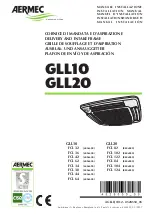
9
3P362438-1B English
7 . Refrigerant pipe size and allowable pipe length
7 .1 . General information
NOTE
The refrigerant R410A requires strict cautions for keeping the system
clean, dry and tight.
•
Clean and dry: foreign materials (including mineral oils or moisture)
should be prevented from getting mixed into the system.
•
Tight: R410A does not contain any chlorine, does not destroy
the ozone layer, and does not reduce earth’s protection against
harmful ultraviolet radiation. R410A can contribute slightly to the
greenhouse effect if it is released. Therefore we should take special
attention to check the tightness of the installation.
7 .2 . Selection of piping material
NOTE
Piping and other pressure containing parts shall comply with the appli-
cable legislation and shall be suitable for refrigerant. Use phosphoric
acid deoxidized seamless copper for refrigerant.
NOTE
• All field piping must be installed by a licensed refrigeration techni
-
cian and must comply with relevant local and national regulations.
•
After piping work is complete, do not under any circumstances open
the stop valve until 9. Field wiring on page 18 and 12. Checking of
device and installation conditions on page 23 are complete.
• Do not use flux when brazing the refrigerant piping. Use the phos
-
phor copper brazing filler metal (B-Cu93P-710/795 : ISO 3677)
which does not require flux. Flux has extremely negative effect on
refrigerant piping systems. For instance, if the chlorine based flux is
used, it will cause pipe corrosion or, in particular, if the flux contains
fluorine, it will damage the refrigerant oil.
•
Use only pipes which are clean inside and outside and which do not
accumulate harmful sulfur, oxidants, dirt, cutting oils, moisture, or
other contamination. (Foreign materials inside pipes including oils
for fabrication must be 0.14 gr/10 ft. or less.)
•
Use the following items for the refrigerant piping.
Material :
Jointless phosphor-deoxidized copper pipe
Size :
See 7.3. Selection of piping size to determine the correct
size.
Thickness :
Select a thickness for the refrigerant piping which
complies with national and local laws.
• For piping work, follow the maximum tolerated length, difference in
height, and length after a branch indicated in the 7.5. System piping
(length) limitations.
•
Outdoor unit multi connection piping kit and refrigerant branching
kit (sold separately) are needed for connection of piping between
outdoor units (in case of multi system) and piping branches.
• Use only separately sold items selected specifically according to
the outdoor unit multi connection piping kit, the refrigerant branch-
ing kit selection in the 7.4. Selection of refrigerant branch kits.
7 .3 . Selection of piping size
Determine the proper size referring to following tables and reference
figure (only for indication).
A
B
B
B
C
D
F
G
E
x
y
b
a
3
1
2
4
5
1, 2 VRV indoor unit
3
BP unit (1 module system only)
4, 5 Mini-split indoor unit (1 module system only)
a, b Refrigerant branching kit
x, y
Outdoor unit multi connection piping kit
7 .3 .1 .
Piping between outdoor unit and (first) refrigerant
branch kit: A, B, C
Choose from the following table in accordance with the outdoor unit
total capacity type, connected downstream.
Outdoor unit capacity
type
Piping outer diameter size
Gas pipe
Liquid pipe
RXYQ72T type
3/4 in. (19.1 mm)
3/8 in. (9.5 mm)
RXYQ96T type
7/8 in. (22.2 mm)
RXYQ120, 144T type
1-1/8 in. (28.6 mm)
1/2 in. (12.7 mm)
RXYQ168-216T type
5/8 in. (15.9 mm)
RXYQ240T type
1-3/8 in. (34.9 mm)
RXYQ264-336T type
3/4 in. (19.1 mm)
RXYQ360-408T type
1-5/8 in. (41.3 mm)
7 .3 .2 . Piping between refrigerant branch kits: D
Choose from the following table in accordance with the indoor unit
total capacity type, connected downstream. Do not let the connec-
tion piping exceed the refrigerant piping size chosen by the general
system model name.
Indoor unit
capacity index
Piping outer diameter size
Gas pipe
Liquid pipe
< 54
5/8 in. (15.9 mm)
3/8 in. (9.5 mm)
54 ≤
×
< 72
3/4 in. (19.1 mm)
72 ≤
×
< 111
7/8 in. (22.2 mm)
111 ≤
×
< 162
1-1/8 in. (28.6 mm)
1/2 in. (12.7 mm)
162 ≤
×
< 230
5/8 in. (15.9 mm)
230 ≤
×
< 300
1-3/8 in. (34.9 mm)
3/4 in. (19.1 mm)
> 300
1-5/8 in. (41.3 mm)
Example:
Downstream capacity for E = capacity index of unit 1
Downstream capacity for D = capacity index of unit 1 + capacity index
of unit 2













































